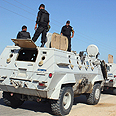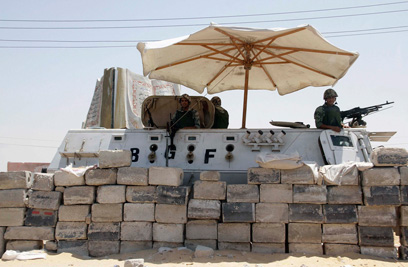
Sinai vacuum a boon to Gaza rocket men
Israeli sources say that Gaza terrorists use Sinai to test rocket range and accuracy
It was soon after the 2011 revolt in Egypt toppled President Hosni Mubarak that Israeli rocket radars began to spot unusual launches from the Palestinian territory, which Israel keeps under a land, sea and air cordon.
Related articles:
- Hamas urges Egypt to open Rafah crossing
- Gaza closure sends prices soaring, smugglers say
- Obama to give Israel $70M for Iron Dome
Normally they streaked towards Israeli border towns, or north towards coastal cities. But now some were aimed at the empty desert wastes of Sinai.
The purpose seemed clear: to test rockets made or smuggled in by Palestinian groups who do not have space for a practice range.
"They have a Bedouin collaborator in Sinai who finds the crater and marks it by GPS," an Israeli official told Reuters on condition of anonymity, describing a low-tech but effective method of tracking test-firings from Gaza.
A sheik from a Sinai village around 60 km (40 miles) from Gaza described how in June he heard several explosions and went to investigate. He found a spent rocket. It had gouged a basketball-size hole in the ground.
"The remaining parts did not include any writings that could tell where the rocket came from," he said.
Google range-finder
Gaza's Hamas government and its smaller Islamist factions deny conducting any military operations in Sinai.
But security officials from Egypt, which is now hunting armed Islamists in Sinai in its biggest military operation there in 40 years, privately admit it has become a playground of bandits, smugglers and terrorists exploiting the free-for-all.
The Israelis who spoke about the rocket tests did so before an Aug. 5 attack on a Sinai border police post shocked Cairo, raising the stakes overnight in what Israel said it hoped would be "a wake-up call".
Gunmen killed 16 Egyptian border guards. Seven terrorists were then killed by IDF forces after they stormed the border in a stolen armored car, some wearing explosive belts.
In the aftermath of the attacks, Hamas said it was arresting radical Salafi Islamists, one of several groups who try to fire rockets into Israel in defiance of de facto Palestinian truces.
Israeli officials will not comment on the record about the Gaza rocket tests, perhaps unwilling to pile another public headache onto Egypt's new, Islamist-rooted government.
When rudimentary rockets emerged in Gaza a decade ago, they were test-fired into the Mediterranean. Splash-downs were calibrated using binoculars and spotters in fishing boats. Since those days, Gaza rocketeers have at times test-launched into Israel's southern Negev desert.
Thanks to advances in Gaza's underground munitions industry and smuggling of military grade rockets from Sinai, ranges have increased and crews need observable impact sites during tests.
Tzvika Foghel, an Israeli brigadier-general in the reserves often garrisoned in the south, recalled occasions when rockets were fired from the far western corner of Gaza at open areas of Israel, a diagonal span of more than 40 km (25 miles).
"They could easily see where the rockets were landing by putting someone in an elevated position in Beit Hanoun," Foghel said, referring to a Gaza town on the Israeli border.
Palestinian sources say rocketeers would monitor Israeli media and police channels after a launch and use the web-based mapping program Google Earth to assess range and accuracy.
Tell-tale debris
Israel's Gaza blockade includes advanced radars to detect and track rocket launches in real-time. The radars feed Iron Dome, an interceptor system that only shoots downs rockets threatening populated areas.
Rockets headed into the open Negev, deliberately or by mistake, are watched with interest by Israeli intelligence.
"There are those who see these practice launches as an opportunity to study what the enemy is planning and preparing for us," said a serving Israeli military officer.
So when Palestinians fire a rocket in practice, the Israelis can study its trajectory and debris. But in Sinai the debris is beyond their reach.
Rockets and mortars have killed 21 people in Israel's south over the past decade. When fired in salvoes, life is suspended for around one million Israelis who live within range, running for shelter to await the blast and the all-clear.
In the southern town of Sderot, a frequent target, the crisis center has a room full of twisted, rusting rocket casings that trace the steady development of this Palestinian arsenal.
According to an Israeli defense official, the Gaza arsenal currently amounts to 10,000 rockets, the more powerful of which reach 70 km (44 miles), enough to hit Tel Aviv.
It is closely watched, and in the fog of war testing can prove just as dangerous for Palestinian militants as war itself.
Life-and-death adventure?
In late October, an overflying Israeli surveillance drone recorded several Palestinians painstakingly off-loading a long, heavy tube-like object from a van and then standing it on what looked like a launch-pad in the southern Gaza town of Rafah. The ensuing air strike on the site killed a senior member of the Palestinian faction Islamic Jihad and four of his comrades.
It may have been the group's bad luck that their appearance coincided with a flare-up of violence that included a rocket being fired deep enough into Israel to set off sirens on the outskirts of Tel Aviv, more than 50 km (32 miles) from Gaza.
"In retrospect, we got information indicating that it was meant to be another test-launch," the Israeli military officer said of the men killed in Rafah.
A rocketeer from one Palestinian faction in the enclave told Reuters such risks are part of the long conflict with Israel that requires either fighting or preparing to fight.
"Every outing with rockets is a life-and-death adventure. It is one we love," he said. "If we live we will be back to fire more, and if we die we go to heaven as martyrs."
- Receive Ynetnews updates directly to your desktop













